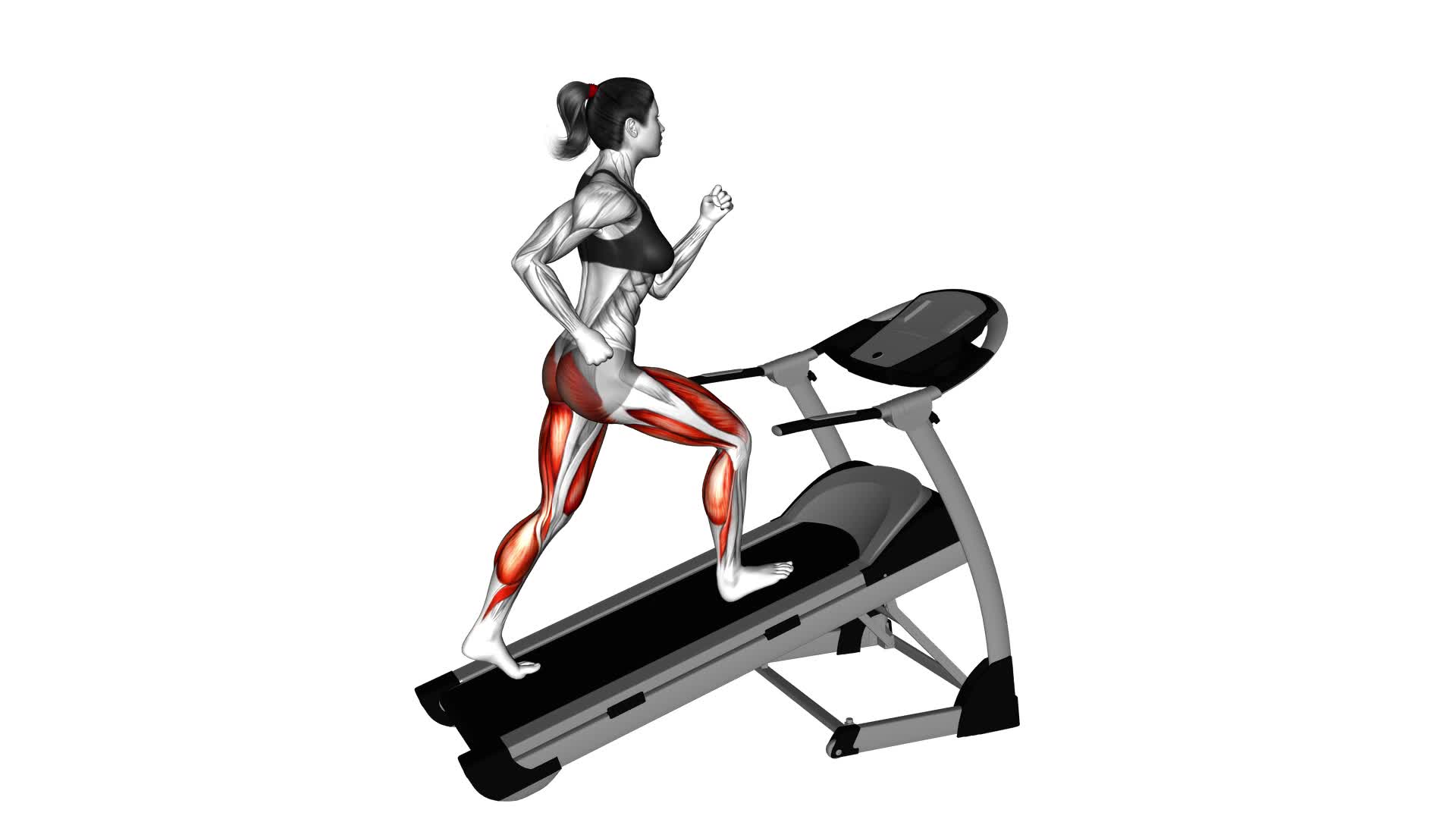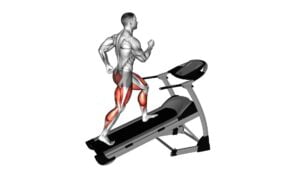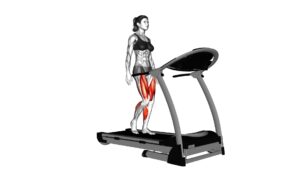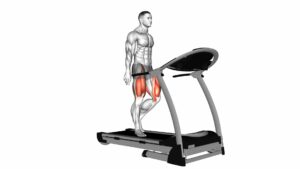Walking on Incline Treadmill (female) – Video Exercise Guide & Tips

Are you looking for a more challenging workout that targets multiple muscle groups? Walking on an incline treadmill might be just what you need!
Watch This Exercise Video
In this video exercise guide, we'll show you the benefits of incline walking, proper form and technique, and how to set the right incline and speed.
We'll also cover variations and interval training to keep your workouts interesting and effective.
Get ready to amp up your fitness routine and see amazing results!
Key Takeaways
- Walking on an incline treadmill increases calorie burn and improves cardiovascular endurance.
- Maintaining proper form and technique, such as good posture and shorter steps, is important while walking on an incline treadmill.
- Starting with a moderate incline and gradually increasing it, as well as adjusting the speed to a challenging pace, is recommended for an effective workout.
- Varying incline levels and incorporating interval training can enhance the intensity and effectiveness of the workout.
Benefits of Walking on Incline Treadmill
Walking on an incline treadmill can provide numerous benefits for you. Not only does it help increase your calorie burn, but it also improves your cardiovascular endurance. By walking uphill on a treadmill, you challenge your body to work harder, which leads to a higher calorie expenditure. This is because your muscles have to work against gravity, requiring more effort and energy. As a result, you burn more calories compared to walking on a flat surface.
In addition to increased calorie burn, walking on an incline treadmill also improves your cardiovascular endurance. The incline adds resistance to your workout, making your heart work harder to pump blood throughout your body. This helps strengthen your heart and lungs, improving their efficiency over time. By regularly incorporating incline walking into your exercise routine, you can enhance your cardiovascular fitness and endurance.
Now that you understand the benefits of walking on an incline treadmill, it's important to focus on proper form and technique. This ensures that you get the most out of your workout while minimizing the risk of injury. By maintaining good posture, engaging your core, and using a controlled stride, you can maximize the effectiveness of your incline treadmill workout.
Proper Form and Technique
To optimize your incline treadmill workout, focus on maintaining proper form and technique. Proper form not only helps prevent injuries but also ensures that you get the maximum benefits of walking on an incline. Here are some tips to help you maintain proper form and technique while walking on an incline treadmill.
First and foremost, it's important to maintain good posture. Keep your head up, shoulders back, and engage your core muscles. This will help you maintain balance and stability throughout your workout.
When walking on an incline, take shorter steps and land with your heel first, followed by rolling through to your toes. This helps to engage your leg muscles and ensures a smooth and efficient walking motion.
Avoid leaning on the handrails or gripping them too tightly. Instead, let your arms swing naturally by your sides. This will help to engage your upper body and increase the intensity of your workout.
Common mistakes to avoid while walking on an incline treadmill include slouching or hunching over, which can strain your back and neck. Also, be mindful of not taking too long of strides, as this can put unnecessary stress on your joints.
Setting the Right Incline and Speed
To maximize the benefits of walking on an incline treadmill, it's important to set the right incline level and speed.
The optimal incline level will vary depending on your fitness level and goals. Start with a moderate incline and gradually increase it as you become more comfortable.
Similarly, adjust the speed to a pace that challenges you but still allows you to maintain proper form and technique.
Experiment with different settings to find what works best for you and remember to listen to your body.
Optimal Incline Levels
To set the right incline and speed on an incline treadmill, you need to adjust the settings according to your fitness level and goals. Setting the incline level correctly is crucial for getting the most out of your workout.
A moderate incline of around 5-7% is a good starting point for beginners. This level of incline helps to engage your glutes, hamstrings, and calves, providing a more intense workout compared to walking on a flat surface.
As you progress, you can increase the incline to challenge yourself further. It's important to maintain proper posture while using the incline treadmill. Keep your head up, shoulders back, and core engaged to avoid strain on your neck, back, and hips.
Appropriate Speed Adjustments
As you adjust the incline level on the treadmill, it's important to also make appropriate speed adjustments to optimize your workout. Speed modifications are crucial in ensuring that you maintain a challenging and safe exercise routine.
When increasing the incline, you should also increase your speed to match the intensity of the workout. However, it's essential to listen to your body and not push yourself too hard. Safety precautions should be taken into consideration when making speed adjustments.
Make sure to start with a comfortable pace and gradually increase it as you feel more comfortable and confident. It's important to maintain proper form and posture throughout your workout.
By making appropriate speed adjustments, you can enhance the effectiveness of your incline treadmill workout.
In the next section, we'll explore variations and interval training to further enhance your exercise routine.
Variations and Interval Training
Now let's talk about some variations and interval training techniques you can incorporate into your incline treadmill workout.
Varying the incline levels during your workout can help increase the intensity and challenge your muscles in different ways.
Interval training, alternating between periods of high intensity and recovery, can also be a great way to boost your cardiovascular fitness and burn more calories.
Varying Incline for Intensity
You can increase the intensity of your workout on the incline treadmill by varying the incline level. Changing the incline not only challenges your muscles in different ways but also increases your calorie burn.
Here are two ways you can vary the incline for a more intense workout:
- Progressive incline: Start with a low incline level and gradually increase it every few minutes. This mimics walking or hiking uphill and engages your leg muscles more effectively. You can also adjust the speed to match the incline for a more challenging workout.
- Interval training: Alternate between high and low incline levels during your workout. For example, you can walk at a moderate incline for a set interval duration, then increase the incline to a higher level for a shorter interval duration. This can help improve your cardiovascular fitness and burn more calories.
Benefits of Interval Training
To maximize the effectiveness of your workout on the incline treadmill, incorporating interval training can provide numerous benefits.
Interval training involves alternating periods of high-intensity exercise with periods of lower intensity or rest.
One of the main advantages of interval training is that it allows you to burn more calories in a shorter amount of time compared to steady-state cardio. This is because the high-intensity intervals push your body to work harder and increase your heart rate, resulting in a greater calorie burn.
Interval training also helps to improve cardiovascular fitness, increase endurance, and boost metabolism.
There are various interval training methods you can try, such as Tabata, HIIT (High-Intensity Interval Training), or Fartlek training.
Targeting Specific Muscle Groups
Engage various muscle groups by adjusting the incline on the treadmill. By increasing the incline, you can target specific muscle groups and enhance the effectiveness of your workout. Here's how adjusting the incline can activate different muscles and maximize your calorie burn:
- Quadriceps: Walking on an incline activates your quadriceps, the muscles on the front of your thighs. As you push off with each step, your quads work harder to lift your body weight against gravity.
- Glutes: Walking uphill engages your glutes, the muscles in your buttocks. The incline forces your glutes to work harder to extend your hip and propel you forward.
- Hamstrings: The incline also activates your hamstrings, the muscles on the back of your thighs. As you walk uphill, your hamstrings contract to help stabilize your knee joint and control the movement.
- Calves: Walking on an incline targets your calf muscles. As you push off with each step, your calves contract to lift your heels and propel you forward.
By adjusting the incline on the treadmill, you can target these specific muscle groups and increase muscle activation. This not only helps to strengthen and tone these areas but also boosts your calorie burn, making your workout more efficient.
Tips for a More Effective Workout
For a more effective workout, try incorporating these tips into your routine.
Improving endurance is crucial when it comes to achieving your fitness goals. One way to do this is by gradually increasing the incline level on the treadmill. Start with a manageable incline and then gradually increase it over time. This will challenge your muscles and improve your cardiovascular fitness.
Another tip is to vary your speed during your workout. Incorporating intervals of high intensity and lower intensity can help to improve your endurance and burn more calories.
Additionally, preventing boredom is important to stay motivated and engaged in your workouts. To do this, you can listen to upbeat music or podcasts that you enjoy. You can also watch TV shows or movies during your workout.
Changing your scenery by exercising outdoors or in a different location can also help to prevent monotony.
Frequently Asked Questions
How Many Calories Can You Burn by Walking on an Incline Treadmill?
Did you know that walking on an incline treadmill can help you burn calories?
In fact, it's a great way to get your heart rate up and increase your calorie burn.
Walking on an incline engages more muscles in your legs, glutes, and core, which can lead to a higher calorie burn compared to walking on a flat surface.
Can Walking on an Incline Treadmill Help With Weight Loss?
Walking on an incline treadmill can definitely help with weight loss. The benefits of incline treadmill walking go beyond just burning calories.
It helps to strengthen your leg muscles, improves cardiovascular fitness, and increases endurance.
To maximize your weight loss, try incorporating interval training into your incline treadmill workout. This involves alternating between periods of high-intensity walking and recovery periods.
It's an effective way to boost your calorie burn and challenge your body.
Is It Necessary to Hold Onto the Handrails While Walking on an Incline Treadmill?
When walking on an incline treadmill, it's important to consider your handrail grip and walking technique.
Many people wonder if it's necessary to hold onto the handrails while walking on an incline treadmill. While it may provide some stability, it isn't necessary if you have good balance and posture.
Focusing on your walking technique and engaging your core muscles can help you maintain your balance without relying on the handrails.
How Long Should a Beginner Start Walking on an Incline Treadmill?
To start your beginner's incline treadmill workout, it's important to gradually increase the time you spend walking on the incline. Begin with shorter sessions of around 10-15 minutes and gradually work your way up to longer durations. This will allow your body to adjust and build endurance over time.
Walking on an incline treadmill offers numerous benefits, such as burning more calories, strengthening your leg muscles, and improving cardiovascular health. So lace up your shoes and enjoy the benefits of this challenging workout!
Are There Any Potential Risks or Injuries Associated With Walking on an Incline Treadmill?
When walking on an incline treadmill, there are potential risks and injuries to be aware of. The incline puts extra stress on your joints, especially your knees and ankles. This can lead to strains or sprains if you're not careful.
Additionally, walking on a high incline for long periods of time can put excessive strain on your cardiovascular system. It's important to start slowly and gradually increase the incline and intensity of your workouts to minimize the risk of injury.
Conclusion
Incline treadmill walking is a highly effective exercise that offers numerous benefits. This includes improved cardiovascular health and increased calorie burn. By maintaining proper form and technique, setting the right incline and speed, and incorporating variations and interval training, you can target specific muscle groups and maximize your workout.
Remember to follow these tips for a more effective workout and enjoy the many benefits that walking on an incline treadmill can provide. Get moving and start walking towards a healthier, fitter you!

Author
Years ago, the spark of my life’s passion ignited in my mind the moment I stepped into the local gym for the first time. The inaugural bead of perspiration, the initial endeavor, the very first surge of endorphins, and a sense of pride that washed over me post-workout marked the beginning of my deep-seated interest in strength sports, fitness, and sports nutrition. This very curiosity blossomed rapidly into a profound fascination, propelling me to earn a Master’s degree in Physical Education from the Academy of Physical Education in Krakow, followed by a Sports Manager diploma from the Jagiellonian University. My journey of growth led me to gain more specialized qualifications, such as being a certified personal trainer with a focus on sports dietetics, a lifeguard, and an instructor for wellness and corrective gymnastics. Theoretical knowledge paired seamlessly with practical experience, reinforcing my belief that the transformation of individuals under my guidance was also a reflection of my personal growth. This belief holds true even today. Each day, I strive to push the boundaries and explore new realms. These realms gently elevate me to greater heights. The unique combination of passion for my field and the continuous quest for growth fuels my drive to break new ground.







